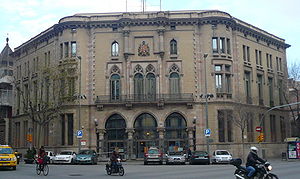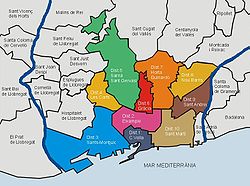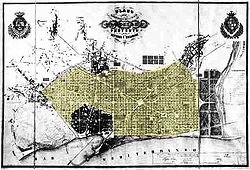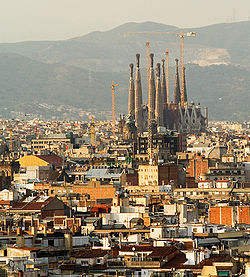
Eixample
Encyclopedia




Barcelona
Barcelona is the second largest city in Spain after Madrid, and the capital of Catalonia, with a population of 1,621,537 within its administrative limits on a land area of...
between the old city (Ciutat Vella
Ciutat Vella
Ciutat Vella is a district of Barcelona, numbered District 1. The name means "old city" in Catalan and refers to the oldest neighborhoods in the city of Barcelona, Spain. Ciutat Vella is nestled between the Mediterranean Sea and the neighborhood called l'Eixample...
) and what were once surrounding small towns (Sants
Sants
Sants is a neighborhood in the southern part of Barcelona, Catalonia, Spain. Formerly an industrial town on the plain bordering Barcelona, known as Santa Maria de Sants, it belongs nowadays to the district of Sants-Montjuïc and is bordered by the districts of Eixample to the northeast, Les Corts to...
, Gràcia
Gràcia
Gràcia is a district of the city of Barcelona, Catalonia, Spain. It comprises the neighborhoods of Vila de Gràcia, Vallcarca i els Penitents, El Coll, La Salut and Camp d'en Grassot i Gràcia Nova. Gràcia is bordered by the districts of Eixample to the south, Sarrià-Sant Gervasi to the west and...
, Sant Andreu
Sant Andreu
Sant Andreu is one of the ten districts into which Barcelona has been divided up since 1984. It was named after a former municipality in the plain of Barcelona called Sant Andreu de Palomar, the largest in the area, which makes up nowadays the bulk of a neighbourhood bearing the same name...
etc.), constructed in the 19th and early 20th centuries.
Its population was 262,485 at the last census (2005).
There are five administrative neighborhoods:
- L'Antiga Esquerra de l'EixampleL'Antiga Esquerra de l'EixampleL'Antiga Esquerra de l'Eixample is a neighborhood in the Eixample district of Barcelona, Catalonia . Originally formed a single unit, called Esquerra de l'Eixample, with the current neighborhood la Nova Esquerra de l'Eixample....
(in the past, part of Esquerra de l'Eixample) - La Nova Esquerra de l'EixampleLa Nova Esquerra de l'Eixamplela Nova Esquerra de l'Eixample is a neighborhood in the Eixample district of Barcelona, Catalonia . Originally it formed a single unit, called Esquerra de l'Eixample, with the current neighborhood l'Antiga Esquerra de l'Eixample....
(in the past, part of Esquerra de l'Eixample) - Dreta de l'EixampleDreta de l'EixampleDreta de l'Eixample is a neighborhood in the Eixample district of Barcelona, Catalonia . It's located east of Carrer de Balmes...
- Fort PiencFort PiencFort Pienc is a neighborhood in the Eixample district of Barcelona, Catalonia . Its name stems from a former military fortification which existed there until the 19th century called Fort Pius, Pienc is an adjective in Catalan meaning related to the name Pius. There's been a strong Chinese...
- Sagrada FamíliaSagrada Família, BarcelonaSagrada Família is a neighborhood in the Eixample district of Barcelona, Catalonia . Its name comes from the temple of the Sagrada Família, work of Antoni Gaudí, which can be found in the center of the neighborhood....
- Sant AntoniSant Antoni, BarcelonaSant Antoni is a neighborhood in the Eixample district of Barcelona, Catalonia . Its non-official centre, the marketplace of the same name, designed by Antoni Rovira i Trias and built between 1872 and 1882, is one of the oldest and most popular in the city, with second-hand book stalls on Sunday...
Architecture and design
The Eixample is characterized by long straight streets, a strict grid pattern crossed by wide avenues, and square blocks with chamfered corners (named illes in Catalan, manzanas in Spanish). This was a visionary, pioneering design by Ildefons CerdàIldefons Cerdà
Ildefons Cerdà i Sunyer was the progressive Catalan Spanish urban planner who designed the 19th-century "extension" of Barcelona called the Eixample.-Biography:...
, who considered traffic and transport along with sunlight and ventilation in coming up with his characteristic octagonal blocks, where the streets broaden at every intersection making for greater visibility, better ventilation and (today) some short-stay parking space. The grid pattern remains as a hallmark of Barcelona, but many of his other provisions were unfortunately ignored: the four sides of the blocks and the inner space were built instead of the planned two or three sides around a garden; the streets were narrower; only one of the two diagonal avenues was carried out; the inhabitants were of a higher class than the mixed composition dreamed of by Cerdà. The important needs of the inhabitants were incorporated into his plan, which called for markets, schools, hospitals every so many blocks. Today, most of the markets remain open in the spots they have been from the beginning.
Some parts of the Eixample were influenced by Modernista
Modernisme
Modernisme was a cultural movement associated with the search for Catalan national identity. It is often understood as an equivalent to a number of fin-de-siècle art movements, such as Art Nouveau, Jugendstil, Secessionism, and Liberty style, and was active from roughly 1888 to 1911 Modernisme ...
architects, chief among whom was Antoni Gaudí
Antoni Gaudí
Antoni Gaudí i Cornet was a Spanish Catalan architect and figurehead of Catalan Modernism. Gaudí's works reflect his highly individual and distinctive style and are largely concentrated in the Catalan capital of Barcelona, notably his magnum opus, the Sagrada Família.Much of Gaudí's work was...
. His work in the Eixample includes the Casa Milà
Casa Milà
Casa Milà , better known as La Pedrera , is a building designed by the Catalan architect Antoni Gaudí and built during the years 1905–1910, being considered officially completed in 1912...
(nicknamed La Pedrera) and the Casa Batlló
Casa Batlló
Casa Batlló is a building restored by Antoni Gaudí and Josep Maria Jujol, built in the year 1877 and remodelled in the years 1904–1906; located at 43, Passeig de Gràcia , part of the Illa de la Discòrdia in the Eixample district of Barcelona, Spain...
, both of which are on the wide Passeig de Gràcia, as well as the Sagrada Família
Sagrada Familia
The ' , commonly known as the Sagrada Família, is a large Roman Catholic church in Barcelona, Catalonia, Spain, designed by Catalan architect Antoni Gaudí...
. Other architects who made highly significant, and certainly more numerous, contributions to giving the Eixample its characteristic appearance include Josep Puig i Cadafalch
Josep Puig i Cadafalch
Josep Puig i Cadafalch was a Spanish Catalan Modernista architect who designed many significant buildings in Barcelona...
, Josep Domènech i Estapà
Josep Domènech i Estapà
Josep Domènech i Estapà was a Catalan architect.He graduated in 1881, and became professor of geodesy and descriptive geometry at the University of Barcelona, and member of the Acadèmia de Ciències i Arts , of which he subsequently became president.His works in Barcelona include the church of...
, Josep Vilaseca i Casanovas
Josep Vilaseca i Casanovas
Josep Vilaseca i Casanovas was a Catalan architect and artist who formed part of the Modernista movement.He studied architecture in Madrid and qualified in 1873. He travelled with Lluís Domènech i Montaner in Germany...
and perhaps above all Enric Sagnier i Villavecchia, responsible for a total of over 500 buildings in the city (not all of them in the Eixample).
The Casa Terrades, better known as Casa de les Punxes, is a spectacular building replete with Mediaeval allusions that stands at the junction of Av. Diagonal with Carrer Rosselló. It was built in 1903-5 by the Modernista architect Josep Puig i Cadafalch, who used Nordic Gothic and Spanish Plateresque resources side by side, along with traditional Catalan motifs.
The Casa Batlló
Casa Batlló
Casa Batlló is a building restored by Antoni Gaudí and Josep Maria Jujol, built in the year 1877 and remodelled in the years 1904–1906; located at 43, Passeig de Gràcia , part of the Illa de la Discòrdia in the Eixample district of Barcelona, Spain...
is part of a block called the Illa de la Discòrdia
Illa de la Discòrdia
The Illa de la Discòrdia , is a block on Passeig de Gràcia in the Eixample District of Barcelona, Spain. The block is noted for having buildings by four of Barcelona's most important Modernista architects, Lluís Domènech i Montaner, Antoni Gaudí, Josep Puig i Cadafalch and Enric Sagnier, in close...
, along with two other notable Modernista works, Lluís Domènech i Montaner's
Lluís Domènech i Montaner
Lluís Domènech i Montaner was a Spanish Catalan architect who was highly influential on Modernisme català, the Catalan Art Nouveau / Jugendstil movement. He was also a Catalan politician....
Casa Lleó Morera
Casa Lleó Morera
The Casa Lleó Morera is a building designed by noted modernisme architect Lluís Domènech i Montaner, located at Passeig de Gràcia 35 in the Eixample district of Barcelona. The building is located on the corner of Carrer del Consell de Cent, and is one of the three important buildings of...
and Josep Puig i Cadafalch's Casa Amatller
Casa Amatller
Casa Amatller is a building in the Modernisme style in Barcelona, designed by Josep Puig i Cadafalch. Along with Casa Batlló and Casa Lleó-Morera, it makes up the three most important buildings in Barcelona's famous Illa de la Discòrdia , noted for its unique modernist buildings.The building was...
. The block is so named due to the visual clash between the buildings; its Spanish name, Manzana de la Discordia, is also a pun on Eris
Eris (mythology)
Eris is the Greek goddess of strife and discord, her name being translated into Latin as Discordia. Her Greek opposite is Harmonia, whose Latin counterpart is Concordia. Homer equated her with the war-goddess Enyo, whose Roman counterpart is Bellona...
's Apple of Discord
Apple of Discord
An apple of discord is a reference to the Golden Apple of Discord which, according to Greek mythology, the goddess Eris said that she would give "to the fairest" at the wedding of Peleus and Thetis, sparking a vanity-fueled dispute between Hera, Athena and Aphrodite that eventually led to the...
- manzana means both "apple" and "city block".
Neighbourhoods
The district is often divided for practical purposes in two: Esquerra de l'Eixample and Dreta de l'EixampleDreta de l'Eixample
Dreta de l'Eixample is a neighborhood in the Eixample district of Barcelona, Catalonia . It's located east of Carrer de Balmes...
(left and right sides of Eixample, respectively). Traditionally and officially it is divided into five neighbourhoods. These are, in addition to the areas already mentioned, Sant Antoni, Sagrada Família and Fort Pienc
Fort Pienc
Fort Pienc is a neighborhood in the Eixample district of Barcelona, Catalonia . Its name stems from a former military fortification which existed there until the 19th century called Fort Pius, Pienc is an adjective in Catalan meaning related to the name Pius. There's been a strong Chinese...
, also known as Fort Pius. The latter has recently become notable for the number of Asia
Asia
Asia is the world's largest and most populous continent, located primarily in the eastern and northern hemispheres. It covers 8.7% of the Earth's total surface area and with approximately 3.879 billion people, it hosts 60% of the world's current human population...
n, chiefly Chinese
Han Chinese
Han Chinese are an ethnic group native to China and are the largest single ethnic group in the world.Han Chinese constitute about 92% of the population of the People's Republic of China , 98% of the population of the Republic of China , 78% of the population of Singapore, and about 20% of the...
residents and the proliferation of Asian shops.
Some parts of Eixample are rather well-to-do neighbourhoods, especially around the central areas such as Passeig de Gràcia, Rambla de Catalunya and the Avinguda Gaudi/Sagrada Familia
Sagrada Familia
The ' , commonly known as the Sagrada Família, is a large Roman Catholic church in Barcelona, Catalonia, Spain, designed by Catalan architect Antoni Gaudí...
vicinity, but it also contains many decaying buildings inhabited by lonely aged tenants on the verge of poverty, especially in the fringe areas. It also has a large proportion of immigrant population.
Main thoroughfares
Passeig de Gràcia connects the central Plaça Catalunya to the old town of GràciaGràcia
Gràcia is a district of the city of Barcelona, Catalonia, Spain. It comprises the neighborhoods of Vila de Gràcia, Vallcarca i els Penitents, El Coll, La Salut and Camp d'en Grassot i Gràcia Nova. Gràcia is bordered by the districts of Eixample to the south, Sarrià-Sant Gervasi to the west and...
, while Avinguda Diagonal cuts across the grid diagonally and Gran Via de les Corts Catalanes runs across the entire city from southwest to northeast.
Other wide avenues in the area include Carrer d'Aragó
Carrer d'Aragó
Carrer d'Aragó is a major thoroughfare in Barcelona, one of the widest and busiest roads of the districts it cuts through, especially Eixample but also Sant Martí. Its creation was passed in 1863, and was part of Ildefons Cerdà's urban plan, appearing as L Street in 1867, even though that name was...
, Carrer de Balmes and Passeig de Sant Joan.
See also
- List of streets and squares in Eixample
- Districts of BarcelonaDistricts of BarcelonaBarcelona, Catalonia, Spain proper is presently divided into 10 districts. These are administrated by a councillor designated by the main city council, and each of them have some powers relating to issues such as urbanism or infrastructure in their area. The current division of the city into...

